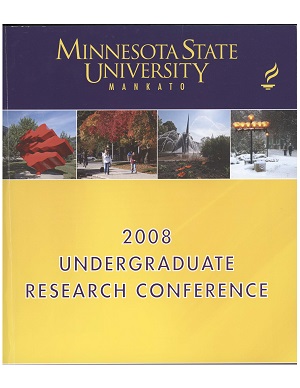The Effect of Aerobic Conditioning Versus Resistance Training on Resting Metabolic Rate
Location
CSU Ballroom
Start Date
21-4-2008 10:00 AM
End Date
21-4-2008 12:00 PM
Student's Major
Family Consumer Science
Student's College
Allied Health and Nursing
Mentor's Name
Susan Fredstrom
Mentor's Department
Family Consumer Science
Mentor's College
Allied Health and Nursing
Second Mentor's Name
Mary F. Visser
Second Mentor's Department
Human Performance
Second Mentor's College
Allied Health and Nursing
Description
Several studies have been conducted analyzing the correlation between exercise and the amount of calories burned at rest (resting metabolic rate). These studies have utilized restricted diets while performing a range of exercises, both aerobic and resistance, and saw a decrease in resting metabolic rate (RMR). Few, if any, previous studies have been performed without a restriction of the subject's diet. Our study looked at the changes in RMR after ten weeks of resistance or aerobic training. We recruited 24 subjects, 16 female and 8 male, and randomly placed them in resistance or aerobic training groups. The subjects ranged from 19-31 years old and had an average age of 21.8. Subjects had a body mass index (BMI) range of 19.7-29.3 and an average BMI of 24.6. The subjects were considered untrained and sedentary. The goal of our research is to determine the degree of increase in RMR between aerobic training and resistance training through overall increased aerobic capacity and strength. Both the aerobic training and resistance training subjects are required to exercise three times per week. Each subject underwent body composition testing, RMR testing and performed diet records. Baseline measurements and post training measurements will be compared and analyzed to determine results. Training is underway and post training data has not been collected at this time.
The Effect of Aerobic Conditioning Versus Resistance Training on Resting Metabolic Rate
CSU Ballroom
Several studies have been conducted analyzing the correlation between exercise and the amount of calories burned at rest (resting metabolic rate). These studies have utilized restricted diets while performing a range of exercises, both aerobic and resistance, and saw a decrease in resting metabolic rate (RMR). Few, if any, previous studies have been performed without a restriction of the subject's diet. Our study looked at the changes in RMR after ten weeks of resistance or aerobic training. We recruited 24 subjects, 16 female and 8 male, and randomly placed them in resistance or aerobic training groups. The subjects ranged from 19-31 years old and had an average age of 21.8. Subjects had a body mass index (BMI) range of 19.7-29.3 and an average BMI of 24.6. The subjects were considered untrained and sedentary. The goal of our research is to determine the degree of increase in RMR between aerobic training and resistance training through overall increased aerobic capacity and strength. Both the aerobic training and resistance training subjects are required to exercise three times per week. Each subject underwent body composition testing, RMR testing and performed diet records. Baseline measurements and post training measurements will be compared and analyzed to determine results. Training is underway and post training data has not been collected at this time.
Recommended Citation
Quast, Rachael L. and Patrick B. Wilson. "The Effect of Aerobic Conditioning Versus Resistance Training on Resting Metabolic Rate." Undergraduate Research Symposium, Mankato, MN, April 21, 2008.
https://cornerstone.lib.mnsu.edu/urs/2008/poster-session-A/5



